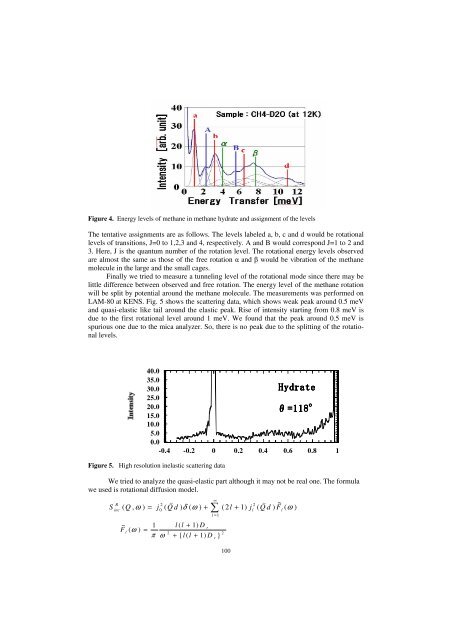Druck-Materie 20b.qxd - JUWEL - Forschungszentrum Jülich
Druck-Materie 20b.qxd - JUWEL - Forschungszentrum Jülich
Druck-Materie 20b.qxd - JUWEL - Forschungszentrum Jülich
Create successful ePaper yourself
Turn your PDF publications into a flip-book with our unique Google optimized e-Paper software.
Figure 4. Energy levels of methane in methane hydrate and assignment of the levels<br />
The tentative assignments are as follows. The levels labeled a, b, c and d would be rotational<br />
levels of transitions, J=0 to 1,2,3 and 4, respectively. A and B would correspond J=1 to 2 and<br />
3. Here, J is the quantum number of the rotation level. The rotational energy levels observed<br />
are almost the same as those of the free rotation α and β would be vibration of the methane<br />
molecule in the large and the small cages.<br />
Finally we tried to measure a tunneling level of the rotational mode since there may be<br />
little difference between observed and free rotation. The energy level of the methane rotation<br />
will be split by potential around the methane molecule. The measurements was performed on<br />
LAM-80 at KENS. Fig. 5 shows the scattering data, which shows weak peak around 0.5 meV<br />
and quasi-elastic like tail around the elastic peak. Rise of intensity starting from 0.8 meV is<br />
due to the first rotational level around 1 meV. We found that the peak around 0.5 meV is<br />
spurious one due to the mica analyzer. So, there is no peak due to the splitting of the rotational<br />
levels.<br />
40.0<br />
35.0<br />
30.0<br />
25.0<br />
������� ������� ������� �������<br />
20.0<br />
15.0<br />
10.0<br />
5.0<br />
0.0<br />
�������� ���� �������� ����<br />
-0.4 -0.2 0 0.2 0.4 0.6 0.8 1<br />
Figure 5. High resolution inelastic scattering data<br />
We tried to analyze the quasi-elastic part although it may not be real one. The formula<br />
we used is rotational diffusion model.<br />
w<br />
w<br />
R<br />
2<br />
2 ~<br />
S ( Q , ω ) = j ( Q d ) δ ( ω ) + ( 2l<br />
+ 1)<br />
j ( Q d ) F ( ω )<br />
inc<br />
0<br />
∑ ∞<br />
l = 1<br />
~ 1 l ( l + 1)<br />
D r<br />
F l ( ω<br />
) = 2<br />
π ω + { l ( l + 1)<br />
D }<br />
r<br />
2<br />
100<br />
l<br />
l

















